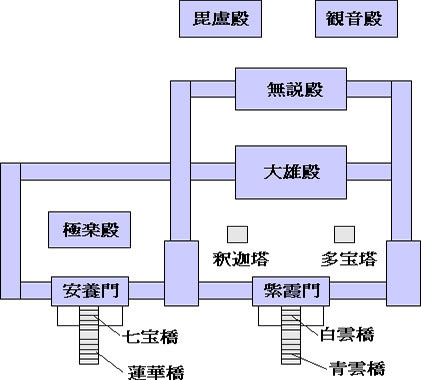

法隆寺と150年ほど遅れて創建の韓国仏国寺の建築文化比較検証シリーズ。
いまから1400年ほど前の法隆寺建築ですが、訪れるといまでも
訪れる者に畏敬の念を抱かせる名建築であることが伝わってきます。
現代でこそ木造建築はごく普通の建築だけれど、
このころの国家事業としての木造建築、しかも五重塔のような多層階まで実現する
技術の粋を凝らした最先端建築であったことが伝わってくる。
庶民は竪穴住居に暮らし、屋根は土屋根・茅葺きが一般的な時代。
もちろん床上げもしていなくて土座の暮らし方だった。そういう状況の中で
基礎も石場立てで長期的耐久性を考慮し、屋根には瓦が葺かれていた。
なによりこの世に涅槃の境地を現出させるという象徴性・コンセプト建築。
五重塔ははるかな未来ランドマークとして見られていたでしょう。
パリのエッフェル塔並みのシンボルとして社会の支配的イデオロギーを表現していた。
「こういう権力であれば受け入れるべきだな」と思わせる威信があった。
古代統一国家として律令制とともに仏教寺院を建立し鎮護国家思想を普及するという
2つの国策は今日の「資本主義と民主主義」と同等の普遍的価値観だったのでしょう。
世界最先端の仏教寺院としてこの法隆寺を建設し、
さらに奈良東大寺をも建立させて統一国家の正統性を表現していった。
過酷な収税と引き換えに思想的正統性を植え付けていったのでしょう。
「このようにありがたい趣旨であるので喜んで税を納めよ」
創建時の仏国寺も新羅国家の同様の目的的建築だったといえる。
さて建築として考えると興味深いのはその「配置構成」。
土塀などで結界を構成してその内部で地上での黄金空間を志向し
そこにいろいろな宗教上のコンセプト建築を配置していっている。
いわゆる「伽藍配置」というものであります。
この配置についての各寺院毎の思想的変化にオモシロさを感じる。
こういう全体としての空間構成という概念はいったいどうやって形成されたのか。
まぁ基本的には仏教の理想世界への考え方なのでしょうが、さて。
あるいは東アジア的な地割り・建築決定論、風水的なものだったのだろうか?
権力は古代以来、王権空間とは別にこのような空間を作っていたという。
日本古代の古墳とは仏教のような世界宗教が受容される以前、
王権の正統性を示す宗教的権威性を訴求するものだったという説が強い。
仏教寺院が日本社会に導入されて以降、神社が建築空間としてのありようを
変えていったことと強く関係しているように思われる。
古墳が徐々に姿を消していったことと、法隆寺のような仏教寺院が
多数建築されていったことには同時平行性が強い。
現世権力は常にこうした正統性を顕示する宗教的空間を持っている。
English version⬇
[What is the deciding idea of the cathedral arrangement? Horyuji Temple and Buddhist Temple-3]
A series of architectural and cultural comparison verifications of Korean Bulguksa Temple, which was built about 150 years later than Horyuji Temple.
It was built at Horyuji Temple about 1400 years ago, but even now when I visit it.
You can see that it is a famous building that makes visitors feel awe.
Wooden architecture is very ordinary in modern times, but
A wooden building as a national project around this time, and even a multi-story floor like a five-storied pagoda
You can see that it was a state-of-the-art architecture with elaborate technology.
The common people lived in pit-houses, and the roofs were generally earthen roofs and thatched roofs.
Of course, I didn't raise the floor and it was a way of living in Tsuchiza. In such a situation
The foundation was also a stone yard, and the roof was tiled for long-term durability.
Above all, the symbolic and concept architecture that reveals the state of Nirvana in this world.
The five-storied pagoda would have been seen as a landmark of the far future.
It expressed the dominant ideology of society as a symbol of the Eiffel Tower in Paris.
There was prestige that made me think, "If you have this kind of power, you should accept it."
It is said that a Buddhist temple will be built along with the decree system as an ancient unified nation and the idea of a nation of protection will be disseminated.
The two national policies would have been the same universal values as today's "capitalism and democracy."
Built this Horyuji temple as the world's most advanced Buddhist temple,
In addition, Nara Todaiji Temple was built to express the legitimacy of a unified nation.
Perhaps they planted ideological legitimacy in exchange for harsh tax collection.
"I am grateful for this, so please pay the tax."
It can be said that Bulguksa Temple at the time of its construction was a similar purposeful building of the Silla nation.
What is interesting when considering architecture is its "arrangement and composition".
A barrier is formed with an earthen wall, and inside it, the golden space on the ground is aimed at.
Various religious concept architectures are arranged there.
This is the so-called "cathedral arrangement".
I feel that the ideological changes of each temple regarding this arrangement are interesting.
How was this concept of spatial composition as a whole formed?
Well, it's basically a way of thinking about the ideal world of Buddhism, but by the way.
Or was it East Asian land allocation / architectural determinism, feng shui?
It is said that power has created such a space separately from the kingship space since ancient times.
The ancient Japanese burial mound was before the acceptance of world religions such as Buddhism.
There is a strong theory that it was an appeal for religious authority that shows the legitimacy of the kingship.
Since the introduction of Buddhist temples into Japanese society, the shrine should be an architectural space
It seems to be strongly related to what has changed.
The tumulus gradually disappeared, and Buddhist temples like Horyuji Temple
Simultaneous parallelism is strong in the fact that many were built.
This world power always has a religious space that reveals this legitimacy.










